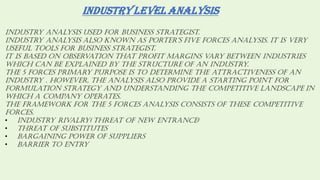
Presentation (6)-1.pdf
- 1. INDUSTRY LEVEL ANALYSIS Industry analysis used for business strategist. Industry analysIs also known as porter’s fIve forces analysIs. It Is very useful tools for business strategist. It is based on observation that profit margins vary between industries which can be explained by the structure of an industry. The 5 forces primary purpose is to determine the attractiveness of an industry . However, the analysis also provide a starting point for formulation strategy and understanding the competitive landscape in which a company operates. The framework for the 5 forces analysis consists of these competitive forces. • Industry rivalry( threat of new entrance) • Threat of substitutes • Bargaining power of suppliers • Barrier to entry
- 3. RESOURCE ALLOCATION • Resource allocation is a process of assigning and managing of asset in a manner that supports an organisation strategic planning goals. • Resource allocation includes managing tangible assets such as hardware to make the best use of assets such as human capital. There are two types of resources allocation: • The method of allocating most suitable resource for projects and tasks is known as resource allocation. • Resource allocation is done with capacity planning. • Resource allocation helps key project progress on track, avoid resource burnout and maintain quality.
- 5. BENEFITS OF RESOURCE ALLOCATION • Collaboration : Resource allocation promotes communication and collaboration across teams. • Efficiency : The availability of resources assists team in completing project on time and uses only the resources required to achieve every goals. • Team morale : Employee participation and team morale rise as a result of resource allocation. It allows for a more balance division of responsibility ensuring that team makes are not overworked. • Cost reduction : It promotes efficiency, minimises waste and avoid costly blunders set backs and delays efficient resource allocation and lead to significant cost saving.
- 6. LEADERSHIP AND CORPARATE CULTURE 1. What we see? • Behaviour • System to adopt • Process • Policies Surrounding the way the things are done 2. What we say? • Goals to achieve • Aspiration • Values, ideal set by the leadership 3. What we believe?
- 7. As a business especially in start-up is upto the founder and CEO’s to show alignment between the companies belief and behaviour that the leadership team reinforce when changing corporate culture. In the early stages, you are focussing building a core team and taking what you value and applying that to your hiring strategies and you grow from those early stages leaders have a responsible help to define team measure and reward the with they want to built.
- 9. VALUES : Values are the organisationspecific feature determiningthe way of thinkingbehaviour and response to the events. • Strategic values is value a purchaser is willing to pay for a business. • Over and above , what an inpartialbusiness values might determine is fair market value. • High value strategy where a higher quality provided and more expansive componentare used.
- 11. ETHICS : Ethic reflect human being and their interactionwith nature and other humans on freedom , on responsibilityand on justice. The most importantbenefit is that code of ethics is that it can foster the environmentof trust , ethicalbehaviour, integrity and excellence. An ethicalcompany runs on principles such as honesty , integrity, fairness, trustworthiness, accountability and respect for others. Ethics traditionally divided into : • Normative • Meta ethic • Applied ethic
- 13. SOCIAL RESPONSIBILITY : • To Owners The business should be managed profitability fair and regular return of capital company should build it image and reputation in the market. • To Employees Fair selection profit training and promotion, wages and incentive, saving and comfortable working condition labour welfare scheme. • To Customers Supply goods at reasonable price not to give a false advertisement, producing and distributing only quality goods. To ensure that the product supply has not adverse affect.
- 14. STRATEGIC EVALUATION AND CONTROL Strategic evaluation and control is the process of determining the effectiveness of a given strategy in achieving the organizational objectives and taking corrective actions whenever required. Control can be exercised through formulation of contingency strategies and a crisis management team. These are the steps you can use to evaluate strategies for your organization: • Establish standards. Before you evaluate a strategy or policy, try to create a set of standards that you can use to measure the progress and goals of the strategy. ... • Measure performance. ... • Analyse results. ... • Make adjustments. ... • Set goals.
- 16. Techniques of Strategy Evaluation : Businesses can go about strategy evaluation by using different techniques. Some of the common techniques include SWOT analysis, gap analysis, and value chain analysis. SWOT analysis helps a business determine its strengths, weaknesses, opportunities, and threats.